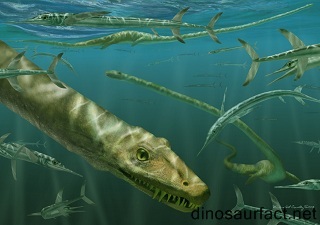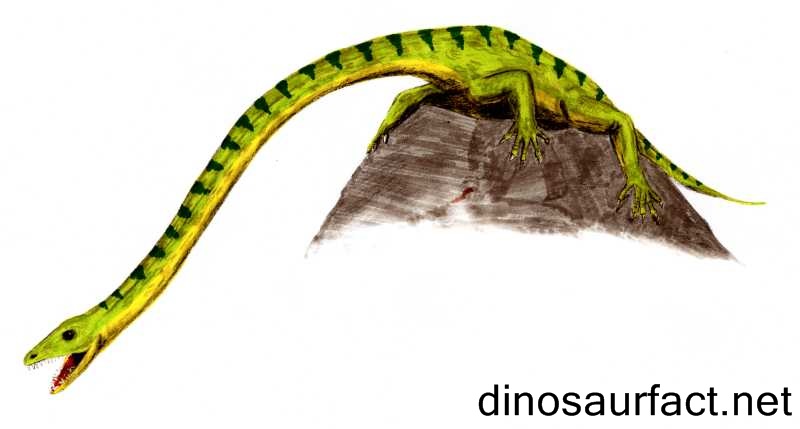 Click to visit the previous Marine Specie bio
Click to visit the previous Marine Specie bio
 |
|
 |
|
Kingdom: Animalia
Phylum: Chordata
Class: Reptilia
SuperOrder: Archosauromorpha
Order: Prolacertiformes
Family: Tanystrophidae
Genus: Dinocephalosaurus
 |
|
 |
|
 |
|

The wider and deeper the oceans, the greater is the mystery around them. Great scientific strides too, haven’t been able to decode certain mysteries of the marine world. So much so, that this mythical aura around the oceans of our planet, have given birth to numerous urban legends. Legends, of mysterious underwater creatures lurking beyond the ambit of the human reach. Legends, of underwater phenomenon, that have managed to elude the humans for too long now.
Perhaps the most famous of all the underwater myths finding mass appeal over the years, is the ‘Loch Ness monster’, a creature alleged to be roaming the Scottish highlands. With a long neck and a Jurassic age appearance, the Loch Ness monster has been in the news since 1933.
However, its existence is highly debatable, since its presence is supported only by vague and alleged sightings. But one creature, that bore the closest resemblance to the above mentioned myth, was the Dinocephalosaurus. With the Loch Ness alleged to be from the same lineage as the Dinocephalosaurus, the latter was more real than the former could ever be.
The Dinocephalosaurus
Despite its name- Greek for "terrible-headed lizard"-the most notable part of Dinocephalosaurus was truly its neck, which was long, thin, and extended for a greater length of this ancient reptile's body (about 5 feet), the biggest distinction between the Dinocephalosaurus and the equally long-necked (and goofy-looking) Tanystropheus, was that the latter is supposed to have been a terrestrial diapsid reptile, whereas the previous spent most of its time within the shallow swamps of Asia, snagging prey with its fishing-pole-like neck and head.
While superficially looking like Tanystropheus, Dinocephalosaurus seemed to be additionally suited to aquatic chase. Key proof for this can be the actual fact that the legs weren't very developed, as compared to the similar Protorosaurs that were land dwelling creatures. The eyes pointing upwards suggest that the Dinocephalosaurus approached its prey from below before attacking. The neck at twenty-five vertebrae was longer than the body and had 2 ribs on either facet that had muscle attachments to support them.
Study of the skeleton has unconcealed a probably distinctive methodology of hunting pursuits. Whereas several aquatic hunters used to create an underwater suction impact by their mouth movements, Dinocephalosaurus seemed to have used its neck ribs, to create the same effect.
This might have greatly raised the amount and power of intake, considerably minimizing the chances of the prey to flee. An alternate theory is that the bone ribs and muscles, that are seen in some terrestrial protorosaurs, served strictly a support purpose.
The discovery
It was the scientists operating in China who discovered this ancient swimming predator, with a neck nearly doubly as long as its body. Science author Chun Li from the Chinese Academy of Sciences in Beijing discovered the reptilian in 2002, within the Guanling Formation in China’s Guizhou Province.
With neck ribs lining the reptile’s five-foot-long (1.7-meter-long) neck that must have helped the creature hunt, some aspects of the animal’s life were comparatively simple to reconstruct: It most likely ate fish and squid, and lurked under a shallow ocean, over 230 million years back.
The most important question regarding this animal is what purpose such a protracted neck must’ve served. With only bones to guide them, the scientists say that it’s dicey to be completely sure regarding the use the creature put its neck to. They do, however, have a vague idea about its predatory skills.
The ultimate hunter
It can be safely concluded, that the Dinocephalosaurus was an adept hunter. A skilled predator of the marine world. To get an estimation of the reptile’s “ridiculous body proportions,” science author Sir Laurence Kerr Olivier Rieppel from Chicago's field repository and his colleagues drew the conclusion of suction feeding, a technique employed by several of today’s fish and turtles.
Fish and turtles drop the floors of their specially designed mouths, thereby increasing volume and decreasing pressure within their throats. This caused the close water (and the potential meal swimming in this water) to flow into the predator’s mouth and throat. This was exactly what the Dinocephalosaurus did.
The Dinocephalosaurus facts
- If the Dinocephalosaurus neck ribs moved the way the scientists assume it did, the pliable neck ribs might’ve pushed on the tissue of the throat and enlarged the throat enough to make suction.
- In a tricky situation, the sheer length of the neck might have helped the reptilian in murky waters close to the shore. The long neck placed the reptile’s brain, mouth and sensory organs well ahead of its body. This neck style might have made it almost impossible for an unsuspecting fish, to see the larger body the below the neck. With this threatening profile hidden, the reptilian must’ve had a lot of time to attack.
- While the scientists cannot ascertain fully, as to how the reptilian must’ve used its neck, they're certain its long neck was built from twenty five elongated neck or “cervical” vertebrae.
- Humans have seven cervical vertebrae and no neck ribs. Our first neck bone, ‘atlas’, begins at the bottom of the skull. Reach back and feel the bump at the bottom of the rear of your neck; that’s your seventh and final neck bone, “C7.”
- If a 6-foot-tall (1.8-meter-tall) person had constant neck-to-body proportions as Dinocephalosaurus, his neck would be just about ten feet (3 meters) long.
- Dinocephalosaurus, was totally different from the other protorosaurs in the sense, that even though it was totally aquatic, it used to lay its eggs on the land. Dinocephalosaurus retained the juvenile characters even during the adult stage. This implies that it must’ve retained its character even once it grew.
- The researches state, that the Dinocephalosaurus could’ve been a very poor swimmer. This assumption is supported by its predatory habit, of staying afloat in the murky waters on the shore, instead of swimming in the deep.
- The long neck of the Dinocephalosaurus, was earlier assumed to be its tail.
Index
Extinct Profiles
 Triassic Dinosaurs
Triassic Dinosaurs Jurassic Dinosaurs
Jurassic Dinosaurs Cretaceous Dinosaurs
Cretaceous Dinosaurs Pterosaurs
Pterosaurs Marine Reptiles
Marine Reptiles Dinosaur Extinction
Dinosaur Extinction